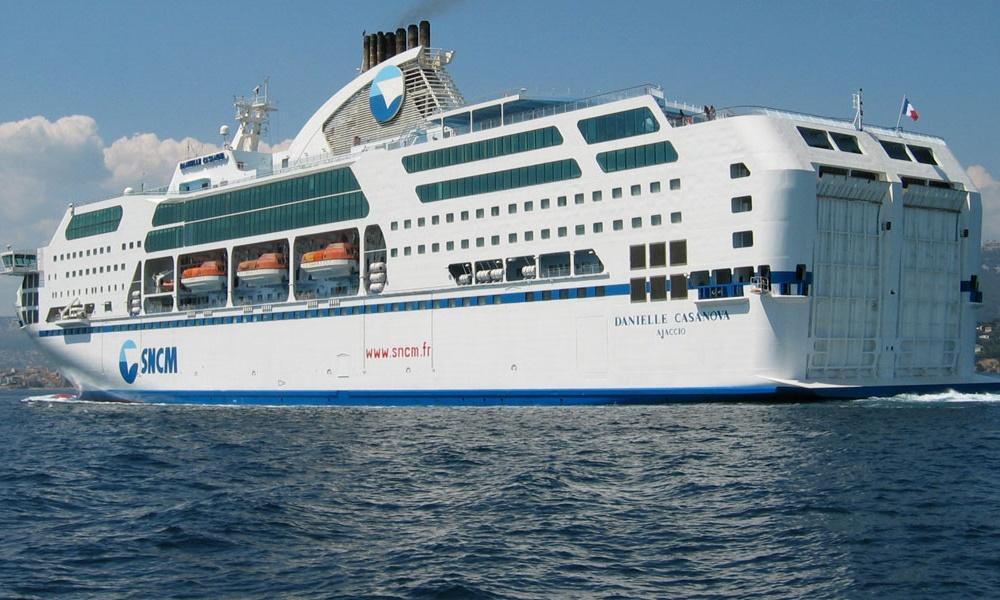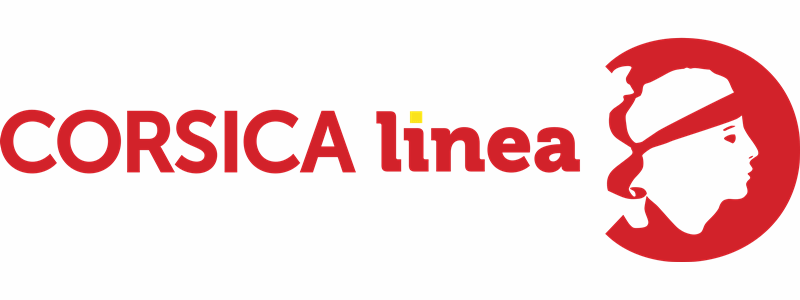Danielle Casanova ferry
Former name: Mediterranee
Danielle Casanova ferry current position
The current location of Danielle Casanova ferry is in West Mediterranean cruising en route to FR MRS P78. The AIS position was last reported 3 minutes ago.
Current PositionSpecifications of Danielle Casanova ferry
| Year of build | 2002 / Age: 23 |
| Flag state | France |
| Builder | Fincantieri (Ancona, Italy) |
| Class | cruiseferry (Ro-Pax ship) |
| Ferry route / homeports | Marseille-Algiers, Marseille-Tunis, Marseille-Corsica (Ajaccio) |
| Building cost | EUR 150 million |
| Speed | 24 kn / 44 km/h / 28 mph |
| Length (LOA) | 176 m / 577 ft |
| Beam (width) | 30 m / 98 ft |
| Gross Tonnage | 41447 gt |
| Passengers | 2400 |
| Crew | 173 |
| Cars | 700 |
| Freight vehicles | 60 |
| Seats | 320 |
| Beds | 1884 |
| Decks | 13 |
| Cabins | 470 |
| Decks with cabins | 5 |
| Last Refurbishment | 2019 |
| Former names | Mediterranee |
| Christened by | Andre Lacrampe |
| Owner | SNCM Maritima Ferries |
| Operator | COSICA LINEA |
Danielle Casanova ferry Review
Review of Danielle Casanova ferry
HSF Danielle Casanova is a Ro-Pax passenger vessel (HSF = High-Speed Ferry) owned by SNCM Maritima Ferries and operated under charter by the France-based company CORSICA LINEA. The ship has a maximum capacity of 2,400 passengers and 700 cars (or 90 cars plus 60 trucks/trailers). Launched in 2002, the vessel currently operates on the France-Algeria route Marseille-Algiers (crossing time 23 hours), the France-Tunisia route Marseille-Tunis (La Goulette) (22.5 hours), and the France-Corsica route Marseille-Ajaccio (12 hours).
Cabins
As a cruise ferry, Danielle Casanova has 470 cabins (188 Inside and 268 Outside), each accommodating up to 4 passengers. All staterooms are located forward on decks 5, 6, 7, 8, and 9. All are air-conditioned, soundproofed, and equipped with en-suite bathrooms (toilet, shower, washbasin, hairdryer), lower and upper wall-mounted bunk beds, bedside table/cabinet with stool or chair, mirrored vanity (small writing desk with chair or stool), telephone, wall-mounted reading lamps, and wardrobe. Bed linens, towels, and toiletries are provided.
- Of the interior cabins, 107 (on decks 6-7-8) have en-suite facilities, while 81 (on deck 5) are fitted with a washbasin only (no WC).
- There are 14 "Luxury" staterooms (2-room suites) on deck 9. Each suite accommodates up to 4 passengers and includes a separate bedroom (double bed) and a living room (2 bunk beds).
- All cabins and hallways are carpeted. Cabins on decks 5 and 7 have green doors, while those on decks 6 and 8 have red doors.
- Stateroom access is electronic, via boarding cards with codes that change for each crossing.
Outside cabins feature a bay window. Suites additionally offer amenities such as HDTV (with satellite reception), mini-bar, double bed, and a 2-seater sofa. Some cabins are wheelchair-accessible. The ship also has 320 reclining seats (aircraft-style) available for pre-booking in the Gibraltar and Bosphorus lounges on deck 5.
TNT television is available in all cabins and in the bar lounge. All passengers must vacate their cabins 30 minutes before arriving at the homeport.

Shipboard dining and entertainment options
Facilities, mainly located on decks 10 and 11, include:
- Two main restaurants: A La Carte Restaurant Les Calanques (open 7:00–9:30 PM) and Self-Service (buffet) Restaurant Les Arbousiers (both on deck 9), offering panoramic floor-to-ceiling windows and meals prepared by French master chefs. Personalized, gluten-free menu options are available.
- Girolata / Snack Bar (cafeteria/patisserie), open year-round, selling sandwiches, pastries, cakes, fruit salads, yogurts, ice cream, and beverages.
- Children’s Room: an indoor kids’ play area with a large HDTV (for cartoons), bean bags, tables and chairs, toys, games, and a ball pit, with supervised activities.
- Sun Deck: includes the Solarium with La Crique (indoor heated pool), sunbathing area (loungers, deckchairs), and outdoor seating served by La Crique pool bar offering fast food, snacks, cocktails, and soft drinks. The area is protected by transparent glass walls.
- Disco Cape Canaille (glass-dome-covered nightclub on deck 10), Video Games Room (arcade machines, foosball), Indoor Bar/Internet Café, The Alhambra / Piano Bar (main bar-lounge for live music), and Marina (meeting/seminar room on deck 9).
- Reserved Seating Lounges Gibraltar and Bosphorus on deck 5 (320 fully reclining Pullman seats, large HDTVs), plus two Truck Driver lounges (restaurant and bar).
- Shopping Arcade (deck 10) with boutiques and a Mini Market selling duty-free alcohol, tobacco, perfumes, cosmetics, fashion, jewelry, electronics, travel essentials, toys, and souvenirs.
- ATM located near the Reception Desk (Lobby Deck). Paid Wi-Fi available in bars and restaurants. Packages can be booked online or onboard at Reception. Wi-Fi is available fleetwide.
- Top deck features a Heli Deck with helipad for emergency use.
- Ample outdoor deck space. Infirmary (ship hospital) with 24-hour medical service.
- 6 large closed lifeboats (capacity ~900 people), 2 semi-rigid boats, liferafts.
Emergency instructions are displayed in cabins, on TV screens, and at assembly stations. Life jackets are issued at these muster stations. Elevators must not be used during emergencies.

Pets on the ship
Pets are allowed on all CORSICA LINEA ships. Dogs and cats must stay in designated onboard kennels. Other animals (rabbits, birds, hamsters, etc.) must be kept in passenger-supplied carriers.
- Pets are not allowed in cabins, seating lounges, bars, or any indoor public spaces. They are permitted only on outer decks, where they may be walked.
- During booking, select "Pet up to 6 kg" for animals in cages not needing kennels. "Pet over 6 kg" applies to animals requiring onboard kennels (advance booking required).
- Pets must be fed and maintained by their owners. Water is provided by the crew. Owners must clean up after their animals.
- Guide dogs travel free of charge and are allowed in cabins. Visually impaired and disabled passengers may travel with assistance dogs.
Car decks
CORSICA LINEA ferries transport semi-trailers, lorries (with or without drivers), cars, motorcycles (as freight only), caravans, camper vans (without drivers), cargo containers, mobile machinery, boats (on cradles), and industrial products.
Car deck safety procedures include:
- Disabled passengers or those needing assistance should visit the 24-hour Information Desk.
- Apply handbrake, engage parking gear or 1st gear, turn off ignition, alarms, electrical systems, and headlights. Shut off gas cylinders. Lock the vehicle.
- Take only essential hand luggage and valuables.
- Note the vehicle's location and deck/stairway number before leaving.
- Access to car decks is prohibited during the voyage.
- Smoking is not allowed on vehicle decks, in cabins, or in lounges.
- Wait for official announcements before returning to your vehicle.
To reduce pollution, engines must not be started until instructed.

The shipowner, Corsica Linea (fleet, founded in 2016, headquartered in Ajaccio, Corsica), is a French shipping company operating exclusively in the Mediterranean Sea. Its routes connect mainland France (Marseille) with Corsica Island (France), Sardinia Island (Italy), and North Africa (Maghreb region – Algeria and Tunisia).
Other CORSICA LINEA cruise ships
Danielle Casanova ferry Wiki
The ship is named after Danielle Casanova (born Vincentelli Perini, 1909–1943), an Ajaccio-born French communist and member of the French Resistance. She was tortured and killed at the Auschwitz concentration camp, where at least 1.1 million people were murdered.
The vessel was ordered on March 23, 2000. Construction officially began on February 28, 2001, with the keel-laying ceremony held at Fincantieri's shipyard in Ancona, Italy. The ship was launched (floated out from drydock) on November 28, 2001, and delivered to the shipowner SNCM (Société Nationale Maritime Corse Méditerranée) on June 26, 2002. The launching ceremony’s godmother (madrina) was yachtswoman Christina Monini. The ship departed Ancona on June 29 and arrived at its homeport, Marseille, on July 1, where it was welcomed by fleetmates Méditerranée, Paglia Orba, and Monte d'Oro. The inaugural cruise (maiden voyage) was on July 2, from Marseille to Bastia, Corsica. On July 5, it began the inaugural Marseille-Ajaccio overnight crossing (9:00 PM – 6:45 AM) under Captain Didier Oberlin.
The cruiseferry was officially christened on July 5, 2002, by godfather André Lacrampe (1941–2015), who was then Bishop of the Roman Catholic Diocese of Ajaccio.
The vessel was transferred from SNCM to MCM (Maritime Corse Méditerranée / CORSICA LINEA) on January 5, 2016. On May 13, the ship departed Marseille for Bizerte (Tunisia) for general maintenance and repainting in Corsica Linea’s new colors and livery (white superstructure and red hull). The EUR 5 million drydock refurbishment project (May 14 – June 14) included renovation of the engines, stabilizers, and bow thrusters. Regular ferry service between France and Tunisia (three weekly roundtrip crossings) resumed on June 22.
In February 2017, MS Danielle Casanova began weekly service between Marseille and Corsica (Bastia and Ajaccio), offering three roundtrips per week during the summer season. During the ship’s drydock in March-April 2019, a Wartsila EnergoProFin (a propeller cap with hydrofoil fins) was installed on the stern propellers (on their post-swirl side) to reduce water flow turbulence on the rudders, thereby lowering fuel consumption and CO emissions.
The cruise ship is powered by four Wartsila marine diesel engines (model 9L46C) with a combined power output of 37.8 MW (50,000 hp). The propulsion system includes two Lips CPPs (controllable pitch propellers, each 5 m / 16 ft in diameter) and two Lips bow thrusters (in-hull units with a combined output of 3.2 MW). The stabilizer system consists of two folding (in-hull) fins that reduce roll motions. The vessel is France-flagged and registered in Port Ajaccio, Corsica. The ferry has a cargo capacity of 1000 lanemeters, accommodating up to 700 cars, or 90 cars plus 60 trucks/trailers.
A fun fact is that the ship's principal equipment was sourced from various European countries: Finland (machinery), Denmark (boilers), the Netherlands (propellers), Czech Republic (propeller shafts), and Spain (car-deck bridges).

